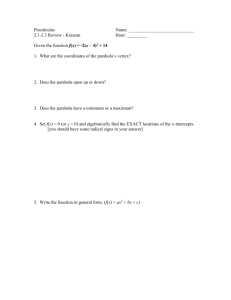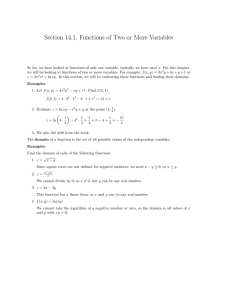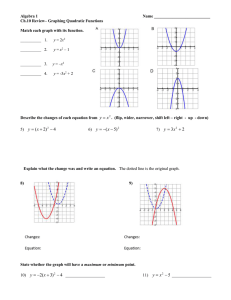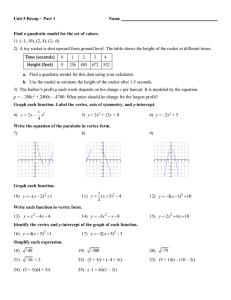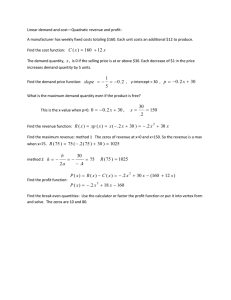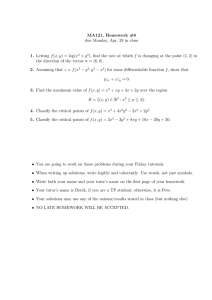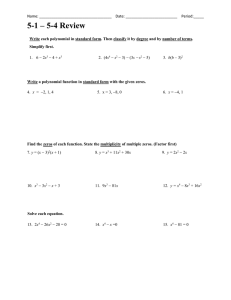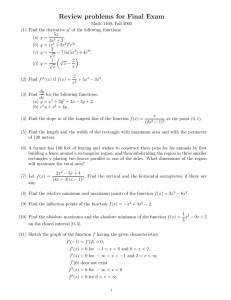Answers to Midterm 1 ;
advertisement
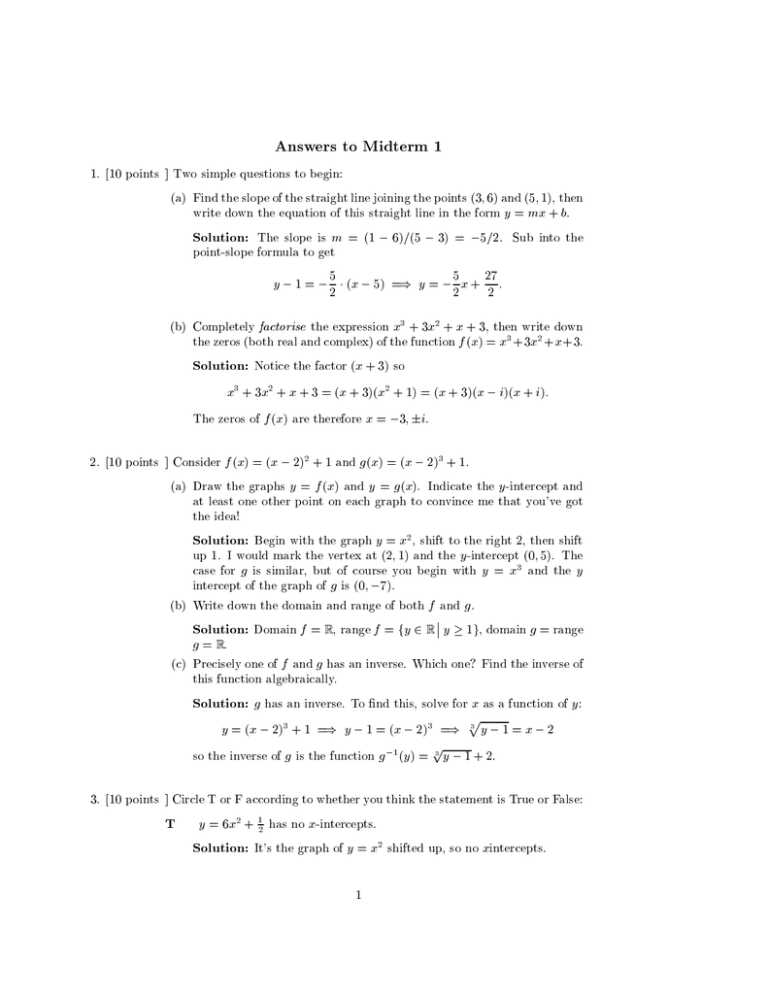
Answers to Midterm 1 1. [10 points ] Two simple questions to begin: (a) Find the slope of the straight line joining the points (3; 6) and (5; 1), then write down the equation of this straight line in the form y = mx + b. Solution: The slope is m = (1 , 6)=(5 , 3) = ,5=2. Sub into the point-slope formula to get y , 1 = , 52 (x , 5) =) y = , 25 x + 27 2: (b) Completely factorise the expression x3 + 3x2 + x + 3, then write down the zeros (both real and complex) of the function f (x) = x3 +3x2 + x +3. Solution: Notice the factor (x + 3) so x3 + 3x2 + x + 3 = (x + 3)(x2 + 1) = (x + 3)(x , i)(x + i): The zeros of f (x) are therefore x = ,3; i. 2. [10 points ] Consider f (x) = (x , 2)2 + 1 and g(x) = (x , 2)3 + 1. (a) Draw the graphs y = f (x) and y = g(x). Indicate the y-intercept and at least one other point on each graph to convince me that you've got the idea! 2 Solution: Begin with the graph y = x , shift to the right 2, then shift up 1. I would mark the vertex at (2; 1) and the y-intercept (0; 5). The case for g is similar, but of course you begin with y = x3 and the y intercept of the graph of g is (0; ,7). (b) Write down the domain and range of both f and g. Solution: Domain f = R, range f = fy 2 R y 1g, domain g = range g = R. (c) Precisely one of f and g has an inverse. Which one? Find the inverse of this function algebraically. Solution: g has an inverse. To nd this, solve for x as a function of y : p y = (x , 2)3 + 1 =) y , 1 = (x , 2)3 =) 3 y , 1 = x , 2 p so the inverse of g is the function g,1 (y) = 3 y , 1 + 2. 3. [10 points ] Circle T or F according to whether you think the statement is True or False: T y = 6x2 + 12 has no x-intercepts. 2 Solution: It's the graph of y = x shifted up, so no xintercepts. 1 (7x + 4) is a factor of a function f (x) if and only if 74 is a zero of f (x). F Solution: (7x + 4) is a factor if and only if , 74 is a zero (2x , 1) is a factor of 6x6 + x5 , 92x4 + 45x3 + 184x2 + 4x , 48. T Solution: Just do the synthetic division to check. No complex number is equal to its conjugate. F Solution: Any real number a 2 R C is equal to its complex conjugate. Every straight line is the graph of a function. F Any vertical line is dened by an equation x = a for some a, but this is not the graph of a function. Solution: 4. [10 points ] (a) Use long division p (any synthetic division junkies will be ogged!) to show that x = 2 is a solution of the polynomial equation x3 + 2x2 , 2x , 4 = 0: Solution: is p p Divide x3 + 2x2 , 2x , 4 by x , 2. The synthetic division p 2 1 -4 p2 p -2 0 2p 2 2p+ 2 4 1 2+ 2 2 2 0 so x = 2 is a zero p of the polynomial x3 + 2x2 ,32x , 24 or, to put it another way, x = 2 is a solution of the equation x + 2x , 2x , 4 = 0. (b) Use your result to part (a) to completely factor x3 + 2x2 , 2x , 4. p p p Part (a) shows that f (x) = (x , 2)(x2 + (2 + 2)x + 2 2). Now factor the quadratic part to leave Solution: p p f (x) = (x , 2)(x + 2)(x + 2): (c) Determine the right-hand and left-hand behaviour of the graph y = x3 + 2x2 , 2x , 4; i.e., state whether the graph rises or falls as you go far to the left and to the right. It behaves like y = x3 far to the right and left. This rises far to the right and falls far to the left. Solution: 2 5. [10 points ] Find the zeros of the function f (x) = x4 + 6x3 + 10x2 + 6x + 9, and write f (x) as a product of linear factors. There's no obvious way to factor, so use the rational zero test. It tells you that possible rational zeros are 1; 3; 9. Substitute these numbers in to see that f (,3) = 0. Now use synthetic division: -3 1 6 10 6 9 0 -3 -9 -3 -9 1 3 1 3 0 so f (x) = (x + 3)(x3 + 3x2 + x + 3): My hope was that you would notice that x3 + 3x2 + x + 3 is the polynomial from question 1(b) so you've already found it's factorisation! So f (x) = (x + 3)(x + 3)(x , i)(x + i): The zeros of f are therefore x = 3; i. 6. [10 points ] A Precalculus Solutions Manual is projected directly upwards from the ground with an initial velocity of 128 feet per second. Its height h at time t is approximately h(t) = 128t , 16t2 . (a) Find the maximum height of the evil book by completing the square. Solution: Solution: h(t) = ,16t2 + 128t = ,16(t2 , 8t) = ,16(t2 , 8t + 16 , 16) = ,16(t , 4)2 , 16 (,16) = ,16(t , 4)2 + 256 Maximum point occurs at the vertex (4; 256), so max height is 256. (b) When does it hit the ground? Solution: Ground is height zero, so solve h(t) = 0, i.e., 0 = 128t , 16t2 = 16t (8 , t): Either t = 0 or t = 8. Of course the rst solution is the moment that the manual is projected up, so the second solution t = 8 is when it hits the ground. (c) Using your answers to parts (a) and (b), draw the graph of the function h(t) = 128t , 16t2, clearly indicating the y-intercept, the x-intercept(s) and the vertex. Solution: The y -intercept is (0; 0), the x-intercepts are (0; 0); (8; 0) and the vertex is (4; 256) so join the dots with a smooth parabola. 3
